#trace elements of iridium
Explore tagged Tumblr posts
Text
You guys wanna see my prized possession?


Not only did I buy it certified but I also have a field geologist buddy who verified using his eyes. 😚
#kt boundary#chicxulub crater#kt extinction event#kaolinite layer#claystone layer#trace elements of iridium#Yucatan peninsula#cretaceous dinosaur extinction event#my post#my prized possession#lignite#luidilovins
32 notes
·
View notes
Text
Osmium Market Explained: The World's Most Densely Valuable Metal
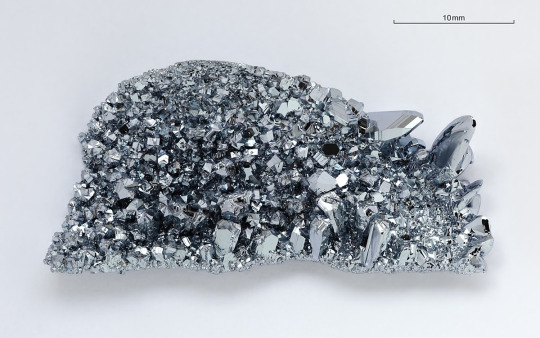
The Osmium market is a niche sector within the broader precious metals industry, often overshadowed by its more well-known counterparts like gold and silver. Osmium is a remarkable element with unique properties that make it a valuable asset for various industries, especially in cutting-edge technologies and scientific applications. In this article, we will explore the Osmium market, its uses, sources, and its potential for growth and investment.
Understanding Osmium
Osmium market is a chemical element with the symbol Os and atomic number 76. It is one of the densest naturally occurring elements and belongs to the platinum group metals (PGMs), which also includes platinum, palladium, rhodium, ruthenium, and iridium. Osmium is characterized by its bluish-white color and extreme density, making it twice as dense as lead.
Historically, osmium was used in various applications, such as fountain pen tips and electrical contacts, due to its hardness and corrosion resistance. However, modern applications for osmium have evolved, and its market dynamics have changed significantly.
Osmium in Modern Applications
Osmium Alloys in Industry Osmium is often alloyed with other metals, like iridium, to create exceptionally hard and durable materials. These alloys find applications in the aerospace and automotive industries, where they are used for electrical contacts, spark plug tips, and turbine engine components. The extreme heat resistance of osmium alloys makes them invaluable in these high-temperature environments.
Scientific Applications In scientific research, osmium tetroxide (OsO4) is a widely used staining agent for electron microscopy and other microscopic imaging techniques. It can highlight cellular structures and biological tissues, aiding researchers in understanding complex biological processes.
Investment Potential The rarity of osmium and its diverse applications make it an attractive option for investors looking to diversify their portfolios. As a tangible asset, osmium can act as a hedge against economic instability and currency devaluation. However, investing in osmium requires careful consideration and knowledge of the market, as it is less liquid than more common precious metals.
Sources of Osmium
Osmium is a rare element found in trace amounts in various ores, with primary sources being platinum and nickel ores. The largest producers of osmium are countries with significant platinum mining operations, such as South Africa and Russia. Extraction of osmium from these ores is a complex and expensive process, which contributes to its scarcity.
Osmium Market Trends
The Osmium market is characterized by its limited supply and steady demand. Over the past decade, the market has experienced modest growth, driven by technological advancements and increasing demand for its unique properties. Some notable trends in the Osmium market include:
Growing Demand in Aerospace and Automotive Sectors The use of osmium alloys in aerospace and automotive applications is expected to increase as manufacturers seek materials that can withstand extreme conditions. Osmium's remarkable hardness and resistance to high temperatures make it a preferred choice in these industries.
Expanding Scientific Research Advancements in scientific research and the increasing need for advanced microscopy techniques are expected to drive the demand for osmium tetroxide, a key component in staining and imaging. This is particularly relevant in the fields of biology, medicine, and materials science.
Investment Opportunities While osmium is not as commonly traded as other precious metals, its investment potential has piqued the interest of collectors and investors. Some institutions and individuals are exploring the possibility of adding osmium to their investment portfolios as a store of value and a hedge against economic volatility.
Challenges in the Osmium Market
Despite its unique properties and applications, the Osmium market faces several challenges:
Limited Supply Osmium's scarcity poses a significant challenge for both industrial users and investors. The small quantities of osmium available and the complex extraction process contribute to its high cost.
Market Awareness The general public and even some investors remain relatively unaware of osmium as an investment option. Increasing awareness and education about the metal's unique characteristics and market dynamics is essential to foster growth.
Conclusion
The Osmium market may be small compared to other precious metals, but its unique properties and applications make it a valuable and intriguing element within the world of commodities and investments. As technology continues to advance and scientific research expands, the demand for osmium is likely to grow, offering opportunities for those willing to explore this less-known sector of the precious metals industry. While challenges such as limited supply and market awareness persist, the Osmium market's potential for growth and investment remains an exciting prospect for those who see beyond the bluish-white surface of this remarkable element.
#Osmium Market Share#Osmium Market Growth#Osmium Market Demand#Osmium Market Trend#Osmium Market Analysis
17 notes
·
View notes
Text
Earth-18104 - The Battle of New York
The story is based on the movie Avengers, with some details from the comics. Most of the characters are changed to fit the original comics lineup of Avengers, and other characters have slight changes in their story, based on my original universe plot.
Like Loki uses different pronouns, Hawkeye and Mockinbird are not part of the team officially, and there's two Nick Fury in this universe: the Colonel, that fought with Captain America during war, and his son Diretor Fury Jr, that looks more like Samuel Jackson's version and is leader of the SHIELD. Also there's a slight addition of my OCs, but they don't even are part of the main story.
List of Events of Earth-18104 (Resume)
Resume of the events of 1990.
1990 -
• (Earth's mightiest heroes)
• (April 1, Sunday)
• On earth, Director Nick Fury Jr (42), Maria Hill (25), Barbara Morse (24), Clint Barton (24), Phil Coulson (43), Henry Pym (27), Janet van Dyne (24) and Erik Selvig are called to the Joint Dark Energy Mission Facility in the Mojave Desert, where Dr. Selvig is researching the Tesseract, which has recently begun emitting strange amounts of energy on its own, leading the facility to be evacuated.
• Aided by Thanos, Loki activates the Tesseract from within the Sanctuary, teleporting to the SHIELD complex. She steals the Tesseract and uses the Scepter given to her by Thanos to control the minds of several S.H.I.E.L.D. agents, including Selvig and Barton.
• They escape and the Tesseract's energy destroys the base, starting the Chitauri Invasion. In response, Nick Fury Jr. reactivates the Avengers Initiative.
• In Asgard, Heimdall sees Loki on Earth with the Tesseract, and informs Thor and Odin, who sends his sons, Tyr, Vidar, Honir, Balder and Thor to Earth to bring Loki back to Asgard for punishment.
• (April 3, Tuesday)
• In Kolkata, India, late at night locally, Barbara Morse tracks down Bruce Banner (28) and tells him that his knowledge of gamma radiation is essential to helping SHIELD locate the Tesseract. Banner reluctantly agrees to help SHIELD.
• In New York City, Steve Rogers (70) sits in his new apartment going through the SHIELD archives. Unable to sleep, he goes to a boxing gym, where Nick Fury Jr. approaches him with a mission to recover the Tesseract.
• Meanwhile, Tony Stark (26) brings his miniaturized Arc Reactor online to power the newly opened Stark Tower in midtown Manhattan, built on the site of the old Pan Am Building.
• Phil Coulson visits Stark Tower and asks Tony to review Erik Selvig's research on the Tesseract, as well as classified material on potential members of the Avengers Initiative.
• (April 4, Wednesday)
• Phil Coulson flies Rogers to the Helicarrier and tells him about the new uniform they have waiting for him.
• There he also meets Bruce Banner, Maria Hill and Barbara Morse; he is impressed when the Hellicarrier takes flight and retroreflective powers to "disappear".
• At the same time, Selvig explains to Barton about his research, saying that he needs iridium, an element that they can find in Stuttgart.
• (Loki's attack in Germany)
• On the Hellicarrier, Bruce gets to work tracking the gamma radiation the Tesseract emits, while SHIELD's spy satellites find Loki in Stuttgart, Germany.
• Hank Pym and Janet van Dyne intercept a transmission from Selvig and trace it to Germany.
• Rogers dons his new Captain America uniform and travels with Hill and Morse in a Quinjet to confront Loki in Stuttgart; the God of Mischief is acting as a distraction while Hawkeye steals iridium to stabilize the Tesseract.
• Loki attacks a man named Heinrich Schafer before terrorizing a crowd of people attending a gala, providing a distraction so Hawkeye can steal iridium.
• Rogers and Morse attack him and a fight breaks out in the crowd. The unexpected arrival of Iron Man, Ant-Man and the Wasp leads Loki to surrender.
• During the confusion, Mockingbird loses sight of Hawkeye and he escapes with the iridium.
• On the way back to the Helicarrier, the Quinjet is ambushed by the princes of Asgard. Tyr, Balder and Honir hold back the Avengers, while Vidar and Thor grabbed their youngest sibling and jumped.
• While Vidar wanted to simply bring Loki back to Asgard to be punished, Thor tried to to reason with them. Loki, blinded by his jealousy of his older brothers and contempt for Odin, refuses.
• The Avengers are not able to go through the princes, as Balder was indestructible and Honir and Tyr had the strength of ten men. Seeing the fight was useless, Wasp reasoned with Balder and explained they needed Loki alive.
• Balder and Wasp made a deal, and Balder allowed them to leave, agreeing that their younger sibling should be taken into S.H.I.E.L.D. custody as long as one of them went along.
• Vidar choose himself, as the oldest, but Thor asked to go with Loki, so he was granted permission, and his brothers went back to Asgard to tell their father.
• Back on the Helicarrier, Loki was placed in a cell designed to contain the Hulk and other super-powered people. The vigilantes and SHIELD agents debate what to do with Loki, giving them time to plan an escape.
• Fury tries to interrogate him about the Tesseract's location, but Loki remains silent.
• The meeting between the heroes was tense at first, but Wasp calmed the nerves and convinced the assembled heroes to help her cause. Thor reveals Loki's plan to the Avengers: with the Tesseract, he hopes to open a portal that will allow the Chitauri access to Earth, thus starting an alien invasion.
• As Pym and Banner work to locate the Tesseract, Tony becomes intrigued by his old college roommate's level of control over the Hulk. Henry is irritated by Tony's attempts to anger Banner, warning him that the Hulk is a danger to everyone on the Hellicarrier.
• Steve, also angered by Stark's erratic behavior and disrespect for authority, tries to get him to follow orders more carefully, which instigates a rivalry between the two. Wasp once again tries to intervene in the fights.
• The five begin to question SHIELD's intentions, deducing that Fury is hiding something about his plans with the Tesseract. Stark reveals that he has begun hacking the agency's mainframe to unlock its secrets, while Rogers leaves to investigate the restricted areas of the Helicarrier for himself.
• Tony also gave Henry access to Stark technology, which he used to build a device that could increase its range and be able to use ants across the country.
• Janet shrinks into a locked room, where she and Steve find several 1940s HYDRA weapons and uniforms in crates in a secret room. With Stark's help, they learn about "Phase 2", a project that aims to use the Tesseract to make weapons.
• (April 5, Thursday)
• In the early hours of the morning, Mockingbird interrogates Loki in their cell, but they refuse to budge. However, in a moment of cruelty towards her, Loki accidentally lets it slip that they're interested in Banner, and Mockingbird realizes that they intend to use the Hulk to escape.
• (Attack on the Hellicarrier)
• As the sun is rising, the Avengers confront Fury with their discoveries, to which he reveals that S.H.I.E.L.D. has begun using the Tesseract to make weapons in response to the Victor von Doom incident last year, the presence of the Skrulls in the planet, the first appearance of the Hulk, the Puppet Master attack, the debut of Iron Man, Ant-Man and the Wasp.
• A large argument ensues, during which Hawkeye, accompanied by several soldiers also working for Loki, attacks the Helicarrier, crippling one of its engines.
• The resulting explosion destroys the laboratory where the group is arguing, causing Janet and Bruce to fall into the boiler area, trapped by the debris.
• Despite Janet's attempts to calm him down, the injured Bruce transforms into the Hulk and chases the Wasp throughout the Helicarrier.
• Thor comes to his rescue and fights with the Hulk, only to be surpassed in strength. A SHIELD jet tries to lure the Hulk away, but he crashes the plane and destroys it. The jet explodes and the Hulk is thrown towards the ground.
• Rogers, Pym, and Stark attempt to repair the damaged engine, but Loki's subordinates hinder their efforts.
• Janet and Mockingbird face Hawkeye and after an intense fight, they manage to break Loki's control by delivering a blunt blow to Barton's head.
• Thor tries to stop Loki from escaping, but is tricked by an illusion of Loki and imprisoned in her old prison cell and takes her out of the Hellicarrier. Thor breaks free of the cell at the last second, falling into a field.
• Rogers, Pym, and Stark finally overcame their attackers and got the Helicarrier back in the air. However, victory is bittersweet when Loki escapes and Bruce disappears.
• Hours later, Hawkeye recovers in the Hospital Wing and rejoins the team, informing them that Loki plans to open the portal above Stark Tower in downtown New York City.
• (Battle of New York)
• Mockinbird (26), Wasp (24), Hawkeye (24), Ant-Man (27) and Captain America (70) take a Quinjet to New York City, following Iron Man (26) in his suit.
• Stark arrives at the tower first, failing to stop Selvig from using the Tesseract to open the portal in conjunction with a device he built.
• Tony then enters the tower to meet Loki, failing to intimidate him. The god of mischief unsuccessfully attempts to possess Stark, as his Arc Reactor physically blocks the scepter's power and instead throws Stark through a window.
• Fortunately, Stark manages to activate his Mark VII armor before he hits the ground.
• Selvig launches the device, opening a portal above New York. The Chitauri fleet appears, beginning Loki's invasion.
• The other Avengers gather on the street to stop the Chitauri, but with the portal open, more and more soldiers arrive. Banner (28) finally joins them on a motorcycle and voluntarily transforms into the Hulk, who stops a large ship with his hands.
• Captain America begins giving instructions to the Avengers to direct their battle strategy against the alien threat.
• He tells Hawkeye to get to a nearby rooftop and assigns the perimeter to Iron Man, sends Thor to try and fire a beam at the portal while Ant-Man closes it, Wasp stays in the air, and Mockingbird and himself stay on the ground.
• Finally he instructs the Hulk to "smash". Hulk jumps from building to building, punching the Chitauri.
• Thor flies to the Chrysler Building to use it as a conduit, building up energy to fire at the portal, eliminating some Chitauri and an approaching Leviathan.
• On the Helicarrier, Nick Fury Jr. examines monitors showing what is happening. Maria Hill (25) says the World Security Council is calling.
• Hawkeye advises Iron Man to lead the Chitauri around sharp turns so they fall. He does so, eliminating the aliens chasing him, and goes to help Thor.
• From the battle, enormous damage is done to downtown New York City, and many lives are lost, but the Avengers save as many civilians as they can.
• Somewhere, Peter Parker and Harry Osborn (9), were returning from school when the attack began. The two boys try to get back to the Parker home safely when they are attacked by Chitauri soldiers.
• Fortunately, they are saved by Captain America, who orders Wasp to take them to a safe place.
• The Wasp shrinks them both and takes them away from the battle. Before leaving, she smiles and the two boys cheer for the heroes before running to the Parker's house.
• While Thor destroys as many ships he can, Heimdall, by Vidar's orders, opens the Byfrost. Vidar, Honir, Tyr and Balder join their brother on the fight, protecting civilians and putting Chitauri down.
• Francine (183) and Antônio Cavalcante (190) (both OCs) were watching the battle. Antônio asks his wife if they should help, when he recognizes Captain America, but Francine says that human problems are none of their business and tells her subordinates to protect themselves, closing the gates of the Sister Margaret's house.
• A Leviathan heads towards a building, the Hulk runs through the building and jumps on it, attacking it in the mouth and redirecting it.
• Captain America tells the Avengers they need to do something about the portal. Wasp grabs Pym and takes him to the top of Stark Tower.
• Hulk attacks a Leviathan, Thor helps him hammer a piece of the vehicle into the Leviathan's back, killing it. He crash lands in Grand Central Terminal, where Hulk also punches Thor in retaliation for earlier.
• Before more debris can fall on the civilians, the Fantastic Four arrive to help.
• The Invisible Woman (26) creates a shield while Mister Fantastic (27) pushes the civilians to safety. Human Torch (18) and the Thing (28) join the Hulk and Thor, causing a brief argument between the four.
• In New York's Sanctum, Stephen Strange (46), Wong (46) and Sara Wolfe (37) help fight the invading forces.
• At the top of Stark Tower, Erik Selvig wakes up, his mind control broken, and sees what is happening around him.
• The military enters the streets to do what they can.
• At Pym's house, his girlfriend Maria Trovaya, watches the fight on the news.
• Hawkeye directs Captain America to a nearby bank, where he goes and stops a Chitauri attack from killing civilians. The Invisible Woman protects the civilians from an explosion, while the Thing catches the Captain before he can fall from the building.
• Ben Grimm is nervous when meeting the Captain and presents himself as a big fan. Susan reminds him of the battle and drives them away with her shields.
• On the Hellicarrier, the World Security Council tells Fury Jr. that they have made the decision to launch a nuclear attack on Manhattan to contain the threat to the island only, but Fury refuses.
• Loki boards a Chitauri vehicle, which is intercepted by Human Torch. Johnny dodges the God of Mischief's attacks and throws her away, throwing her into Stark Tower, where the vehicle drops the "S" and "T" from the logo.
• Mister Fantastic scolds Johnny for losing sight of the "big villain", but Hulk jumps into the tower and attacks Loki, who tries to intimidate him; Hulk just grabs them and throws them to the ground repeatedly, leaving her unable to move.
• Wasp and Ant-Man meet Selvig in the tower, who says he believes Loki's Scepter, lying on the ground below them, may be able to close the portal.
• Iron Man finds himself unable to break through the shell of a Leviathan whale, so he tries to fly directly into its mouth, managing to explode it from the inside. He falls to the ground and finds himself fighting Chitauri again.
• Hawkeye runs out of arrows and has to kick an attacking alien off his perch. When his building is attacked, he jumps, firing a hook arrow to swing through a window below.
• He reaches the sidewalk, where he meets Mockingbird and they fight side by side.
• At Salem Center, Scott Summers, Bobby Drake, Warren Worthington III and Jean Grey watch the news. Scott asks the professor why they won't join the fight. Xavier simply says that them, as students, are not ready yet.
• Somewhere in Brooklyn, Sanguinária (OC) and Sabretooth takes down a Leviathan with their powers. They notice Captain America on TV and grin.
• The World Security Council orders a nuclear attack on Manhattan and a pilot will take off. Fury Jr. arrives with a rocket launcher and manages to hit the jet, but another jet flies in to launch the missile. He calls Stark and tells him that there is a missile heading to New York in the next 3 minutes.
• Wasp grabs the scepter. She, Selvig, and Pym work together to break the Tesseract's defenses to close the portal. Stark asks them to wait, saying there is a missile coming and he wants to send it through the portal.
• Stark grabs the missile just in time and begins to change direction. JARVIS tries to call Pepper Potts (29) in case he dies taking the missile through the portal. However, Potts, on a flight, is too preoccupied with watching the news to see her phone ringing.
• SHIELD watches the news closely on the Helicarrier. Just like every civilian, mutant and human, in New York.
• Stark diverts the missile into the air at Stark Tower and through the portal.
• SHIELD cheers with relief for New York, although Fury is worried about Stark.
• Peter Parker and Harry Osborn cheer in the living room, while Ben and May Parker (46) look fearfully at the TV.
• Strange, Wong and Sara Wolfe watch from the security of the Sanctum.
• Stark finds himself in deep space and his suit begins to fail. He releases the missile and it continues flying, hitting the Chitauri mothership and causing a huge explosion, which causes the remaining fleet of Chitauri and Leviathan to crash and fall dead without the mothership's power.
• Stark falls toward the portal, but the explosion threatens to hit Earth as well, so Rogers orders Pym and van Dyne to close the portal.
• Tony falls back into the New York sky just before its closure, but continues to fall, unconscious. Hulk jumps and catches him to slow his fall.
• The Fantastic Four and the rest of the Avengers crowd around Stark, Reed Richards manages to wake him up. Steve says they won and Tony says they should celebrate with shawarma, but Johnny reminds him that he lost sight of Loki.
• At Stark Tower, Loki recovers from Hulk's beating and the Avengers arrive to arrest her.
• A team from the Damage Control Department arrives at the Avengers' floor of Stark Tower to retrieve the Scepter. Jasper Sitwell takes the Scepter and he and Brock Rumlow (29) guard it.
• While the SHIELD agents guard the Tesseract, Tony invites the Fantastic Four to go eat shawarma and they accept.
• A little after the battle, at Thanos' ship on space, Gamora (29) talks to her master about Loki's defeat, the loss of the Tesseract and Earth's new protectors. He claims that attacking Earth again would be an act of suicide.
• Thanos (975), simply turns and smiles, thinking about what's to come.
• (April 6, Friday)
• The New York Bulletin has a front-page article titled "Battle of NY" that depicts a Leviathan causing several deaths by crashing into a building.
• The world, changed once again by the emergence of superhumans, is dominated by the idea of a team of superheroes.
• The Avengers become the center of media attention, admired by the public as heroes, but are also received with some concern and fear. Some feel that his appearance during the battle is too coincidental.
• (April 11, Wednesday)
• Gathering in Central Park, the Avengers and SHIELD watch as Thor escorts Loki and the Tesseract to Asgard.
• Nick Fury Jr (42) talks to Colonel Fury Sr. (82), saying that the moment a new global threat emerges, the team will come together.
• Odin sentences Loki to an eternity of imprisonment in the Asgardian Dungeons and the Tesseract is put in a safe chamber inside the castle, watch by guards and Heimdall.
• (April 15, Sunday)
• Tony Stark (26) and Pepper Potts (29) review plans to rebuild the damaged Stark Tower, which lost the "S", "T", "R" and "K" outside in battle. They choose to repurpose the remaining "A" to represent the newly formed group, renamed "Avengers Tower".
• Tony reunites with Pym and helps him improve Janet's Wasp costume.
#marvel#Avengers#tony stark#thor odison#henry pym#janet van dyne#barbara morse#mockingbird#hawkeye#clint barton#captain america#iron man#hulk#bruce banner#ant man#nick fury#loki laufeyson#earth-18104#original universe#citruswriting
3 notes
·
View notes
Text

The alpha Brain wave Yoga and
Monatomic gold
The alpha brain wave is well known in tibet for their deep states of mediation ,
Ormus gold or Monatomic Gold puts the body in the elite Alpha brain wave state, a meditative and healing state 7.83 Hz and the earth’s frequency vibrates at 7.83Hz. An unusual coincidence.?
It has been proven to balance the left brain right brain hemispheres
A small study
looked at a brain stimulation technique called transcranial alternating current stimulation (tACS) and found that it could increase alpha brain waves and reduce depression symptoms in people affected by major depressive disorder (MDD).
https://health.com/heath/clinical-depression
Ormus Gold also cleans the body of toxins and increases one’s aura so that the body is functioning on a high vibration and energy status.
How Ormus Monatomic Gold is beneficial for immune system?
Ormus has the ability to alkalise the body’s system due to its high PH levels, an environment that disease doesn’t like.
A nutritous organic substrate full of trace elements .
Elixir Ormus also increases your aura, the energy around the body that senses peoples energy from cortisol being released from the cells in the body.
Have you noticed when you can sense a persons agitated or angry when you enter a room its because they are releasing cortisol and we have tiny receptors in our cells that pick up on this. When this aura is increased our intuition is raised.
Negative sentiment on Ormus or Monatomic gold
There is negative sentiment over the internet on some accounts like any product ,and Ormus can be harmful if made with Dead Sea salt , Compared to Pacific Ocean sea salt ,or if the proper alchemic procedures are not followed. Some of this negative sentiment could be attributed to this .
Is Ormus Dangerous
There are several ways of extracting or processing Ormus or Monatomic gold, some use real golden heat it and use hydrochloric acid and a number of horrible processes, or a Dry method ,
Im relating to particularly the Wet Method made from Organic Sea water harvested from safe places away from marinas.
A Japanese scientist also did study on just sea water he called it Hado water
study on sea water benefits
The simple method layman's explanation is clean filtered sea water is obtained then to raise the PH to 10.78 no higher or dangers can occur ,Vortex the water then the white precipitate falls out with all the minerals , Ph needs to be adjusted then the solution needs to washed many times to remove the high concentrations on sodium . Please don't use this method it s a lot more complicated and a alchemist will need to follow the correct recipe from ancient Egyptian clay tablets.
After researching approx 100 websites reviews it seemed approx 80% are positive on a generalisation with some astounding claims.
However many companies don't have a spectrometry detailed assay list of trace elements.
If done correctly Ormus becomes the Ancient Egyptian elixir that was believed that the Pharos and kings ingested for higher spiritual consciousness and longevity that is completely organic and GMO free.
But do your homework on the trace minerals and see what you think.
SPHINX ORMUS Ormus assay
Other elements to be found in this form are Copper,Cobalt,Ruthenium,Rhodium,Silver,Palladium,Platinum,Osmium,Iridium,and nickel due to there Monatomic form they do not show up under spectrometry.
.[Parts per million]
These organic minerals relate to historic nutritional research of assisting Cognitive function,
Wound healing for burns,
Reducing stress anxiety and depression,
Elasticity of the skin and collagen production reducing wrinkles,
Assisting the nervous system,
Increasing brain blood circulation and electro impulses and cognitive function. Anti-inflammatory properties are helpful for many autoimmune diseases and Arthritis,
Detoxification and rid of free radicals.
Boron
17
Helps build strong teeth and bones, has anti-inflammatory properties helpful for arthritis, speeds up wound healing, Prevents vitamin D deficiency, and balances hormones.
Sulphur 587
Increasing circulation to the brain is helpful for Alzheimer’s or Dementia, It assists in detoxing the body, and is essential to connecting tissues, helping elasticity to the skin reducing wrinkles, it supports insulin production, assists in vitamin B uptake to convert carbohydrates to energy.
Sodium 8,264
Improves heart performance, and the nervous system, prevents muscle cramps, and assists in glucose absorption, sodium is needed for blood regulation, it regulates the bodily fluids and transmits electrical impulses in the body, prevents sunstroke, improves brain function, defends free radicals and is in many skin care creams, eliminates carbon dioxide and controls blood pressure.
Magnesium 2,350
Regulates blood sugar, boosts athletic performance, is involved in approx 600 reactions in your body, energy creation, protein formation, muscle movement, nervous system regulation, may reduce anxiety and combat depression, boast anti-inflammatory properties, bone Heath, gives good sleep,
Potassium 1,317
Stimulates neural activities,, improves the nervous system, regulates fluid systems, maintains water balance, reduces anxiety and stress levels, boosts heart health, boosts metabolisms, strengthens muscles, stabilises blood pressure, enhances bone health, stabilises blood sugars,
Aluminium
2.42
Is ok in small doses it’s in all our vegetables and water and is good for painful joints and alleviates fatigue, The average daily intake is 10 mg per day.
Aluminium RDL
Aluminium is toxic if exceeding the daily recommendations
Silicon
17
Strengthens Bones prevents baldness and Alopecia, prevents brittle nails, is good for skin, assists in elasticity, reduces ageing, increases collagen, restores mucosa, prevents Atherosclerosis, promotes healing, and prevents aluminium toxicity.
Gold
42
Gold is a great anti-inflammatory, as is a superconductor assisting the neural pathways.
It has been used in ancient cultures to increase longevity and enhance spiritual awareness,
LT Lawrence Frego stated Gold raises the IQ by 20 basis points over 30 days
Phosphorus. 49
Strengthens teeth and bones, detoxes the body, supports cognitive development, stimulates protein metabolism, boosts cell repair, helps hormonal balance, promotes metabolism, facilitates nutrient uptake
Calcium
1,077
Strengthens bones and teeth, assists in a stable weight, protects cardiac muscles, has anti-cancer potential, reduces pre-menstrual depression, prevents kidney stones, controls the alkaline PH, regulates blood pressure, and assists transportation of nutrients
Strontium 9.28
Strengthens bones and aids in alkalising the bones. Assists in the absorption of calcium, Prevents tooth decay, is used in treating prostate cancer,
Lithium
2.88
Lithium is used for treating depression, and anxiety, it has anti-inflammatory properties, and it boosts cognitive function. Tests in 26 counties in Texas in 1990 showed that counties with a low rate in the water had a 40% higher suicidal rate
Barium 0.38
Other organisations have set guidelines or regulations pertaining to the concentration of barium in drinking water. The World Health Organisation established a guideline for drinking- water quality of 1.3 mg/L for barium. The United States Environmental Protection Agency’s standard and the guideline established by the Australia National Health and Medical Research Council are both set at 2.0 mg/L. The European Union has not established a limit for barium in drinking water. High quantities of barium above daily intake are harmful.
Iron 2.88
Enhances Haemoglobin, regulates body temp, treats Anaemia, oxygen carrier prevents chronic fatigue, assists energy and metabolism, improves appetite, prevents restless leg syndrome, prevents hair loss, improves muscle health, improves brain function and development, boosts immunity, promotes sleep, boosts concentration, helps heal wounds, neurotransmitter synthesis
Zinc 0.52
Wound healing, DNA synthesis, Protein synthesis, Gene expression, and Immune function, Aid in the growth development of Mitosis and cell division.Anti-inflammatory.
Manganese 0.39
Bone health and strong antioxidant properties help reduce diseases, reduce inflammation, particularly with chondroitin and Glucosamine. Assist in blood sugar regulation, is Linked to lower amounts of epileptic seizures, assists in the role of metabolising nutrients may reduce PMS symptoms in conjunction with calcium, may protect the brain from free radicals and improve brain function. Assist in good thyroid health. assist in wound healing by aiding in collagen production.
After reading my List of Minerals / Trace Elements In Ormus I suggest you google the daily intakes for each mineral and do the math. It is important not to exceed the daily does of Ormus as its such a rich mineral elixir you can exceed the daily recommended doses. I suggest you google to do the RDL under the world health organisation.
It is also great for plants here is a organic broccoli I grew from watering with
1 teaspoon per 10 litres approx 10 times, sitting on a 10 litre water bottle.
How Energy Affects Ormus
If you are interested in energy Ormus has some very unique traits,
You will be aware no doubt of Dr emoto research on structured water
how he found that thoughts directed at water can change the structure of water and words written on water containers can change the shape of the water molecule.
Dr Emoto study video
Research has shown that water can carry as much as 440,000 pieces of information on each molecule , and we are made up of approx 70% of water ,look at the quantity of this stuff we consume ,
approx 730 litres a year to the average person at 2 litres a day.
If we consume that much water wouldn't it be clear that we would want the most pure and high vibrational nature?
If it carries memory surely this would affect us?
Ormus has also been found in the human body ,plants and soils and rocks and is in high concentration in Purple coloured foods and products of the ocean like sea weed, sea food,
Wouldn't it be fair that you would only want to drink liquids in this hexagonal shape of love ? as in the photo here after the frozen water molecules is put under a microscope .
The negative thought traits and words certainly show a negative vibe , you be the judge!
Different ways of supercharging your Ormus into the Hexagonal water molecule elite state. From the earths energy .Ormus is very sensitive to sound and vibration.
Raise your vibration with Ormus
Sacred geometry
crystals and grids
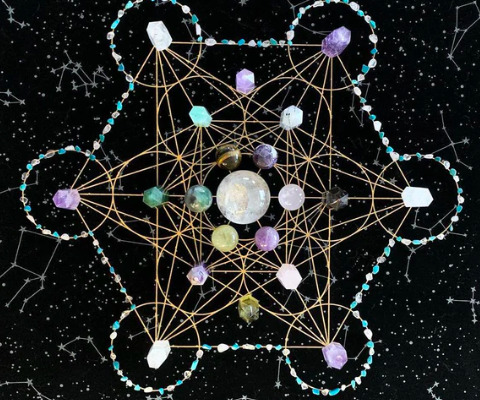
Violet coloured glass and the violet coloured spectrum
528 Hz imprinted in the Ormus [the miracle tone]
The OHM tone
Triskelions [ a sacred Egyptian length of copper formed into a geometric shape giving off electromagnetic energy proven to structure water within hours
Copper torson rings [ reduce the EMF ]
intensions of love kindness and compassion your dreams affirmations and goals.Imprint the water with these memories and then consume them .
Vortex the water [ toroidal energy ] this energy is all of nature from the solar system , the DNA, the merkaba of the heart, Plants or just water spinning down the plug hole,.It even comes down the Egyptian pyramids to the kings chamber.

Pyramidal energy
Using these energies you can raise the vibration and the structure and the memories of your Ormus and help manifestations speeds.
Peoples claims are predominant in energy boosts, and stamina.
Ormus vibrational healing methods
People are discovering ormus after the recipe was hidden in ancient texts from alchemists guarding there valuable substance, but its clear that people are doing there research and key words on google for Ormus using 236% and monatomic gold 126% for 2022 alone
Make your own decision to this organic substance and do a thorough research to this truly interesting substance that has many uses
2 notes
·
View notes
Text
Platinum
Platinum: Platinum is a dense, stable, and rare metal. It is more expensive than gold which is often used to look like its attractive silver. It is also used in medical, electrical, and chemical applications due to its other chemical and physical properties. About 250 metric tons of Platinum is supplied every year. Most of the Platinum produced in the world comes from South Africa and Russia. Known as Platinum Silver White. However, it was once known as white gold. It is a very soft and corrosive metal. This metal is not oxidized and is not attacked by ordinary acids. That is, Platinum is one of the metals. Non-metallic atomic structures mean that they can easily bond with other elements. It is best known for its use in jewelry production, but its main applications are catalytic converters, electrical communications, pacemakers, drugs, and magnets.
Origin of Platinum: Archaeologists have found traces of Platinum in the gold used in ancient Egyptian cemeteries up to 1200 BC. For example, a small box was found in the tomb of Shepenpet II, decorated with gold-platinum hieroglyphics. However, the extent of the early Egyptians' knowledge of metal is unclear. It is possible that they did not recognize that the gold contained Platinum.
Near Esmeraldas in Ecuador, Colombian Americans use metal to make white gold-platinum alloy. Archaeologists generally associate the platinum-working tradition in South America with the La Tolita Culture (circa 600 BC-AD 200), but the exact date and location are difficult, as most platinum artifacts from the area were purchased secondhand instead of antiquities directly by archaeologists. To make metals work, they would combine gold and platinum powder by sintering. The resulting gold-platinum alloy will then be soft enough with the help of the instrument. The Platinum used in such materials was not a pure ingredient but a naturally occurring alloy of the platinum group metals with small amounts of palladium, rhodium, and iridium.
European Discovery: The first European reference to Platinum appears in 1557 in the writings of the Italian humanist Julius Caesar Scaliger as a description of an unknown gem found between Darian and Mexico, "which has not yet been able to liquefy any fire or any Spanish craft." 5]] From their first encounter with Platinum, the Spaniards generally viewed metal as a form of impurity in gold, and so it was considered. It was often removed, and there was an official decree to ban gold adulteration with platinum impurities.
In 1735, Antonio de Ulloa and Jorge Juan y Santasilia saw Native Americans digging Platinum while the Spaniards were traveling through Colombia and Peru for eight years. Ulloa and Juan find mine with white metal pulses and take them to Spain. Antonio de Ulloa returned to Spain and established the first Mineralogy Lab in Spain, and he was the first to study Platinum in 1848. Ullah also expected the discovery of a platinum mine. After the report was published in 1748, Ulloa did not continue to investigate the new metal. In 1758, he was sent to Juancavelica to oversee a mercury mine. In 1741, Charles Wood, [54] a British metallurgist, found various samples of Colombian Platinum in Jamaica, which he sent to William Brownrigg for further investigation.
In 1850, after studying the Platinum sent by Wood, Brownrigg presented a detailed description of the metal to the Royal Society, stating that he had not mentioned it in any previous description of the mineral. [55] Brownrigg also noted the extremely high melting point of Platinum and disobedience to borax. Other chemists across Europe soon began studying Platinum, including Andreas Sigismund Marggraf, Thorburn Bergman, Johns Jacob Bargelias, William Lewis, and Pierre McWarr. In 1752, Henrik Schaefer published a detailed scientific account of the metal, which he referred to as "white gold," including a description of how he had succeeded in fusing platinum ore with arsenic. Schaefer described Platinum as less flexible than gold but similar to corrosion resistance.
Platinum Features:
Symbol- Pt
Atomic number- 78
Group- 10
Stage- 6
Block- D
Electron Formatting- [Xe] 4f14 5d9 6s1
Atomic mass- 195.064 (9) g / mol
Physical condition- grayish-white
Chemical class- absurd element
The number of electrons in each energy level- 2,6,16,32,16,1
Density- 21.45 g / cm6
Melting point- 18.3 C
Footnote- 3725 ° C
Heating capacity- 25 ° C
Oxidation conditions- 2,3,4
Atomic radius- 135 pm
Uses of Platinum: Platinum is a precious metal. It is used in many different ways. It is used to make catalyst converters, laboratory equipment, electrical contacts and electrodes, platinum resistance thermometers, dentistry equipment, and a variety of jewelry. Platinum is also used for computer hard disks and thermocouples. Platinum is also used in the chemical industry as a catalyst for the production of nitric acid, silicon, and benzene. It is also used as a catalyst to improve the efficiency of fuel cells. Platinum is also used to make optical fiber and LCD, turbine blades, spark plugs, pacemakers, and dental fillings. Its compounds are also important chemotherapy drugs used to treat cancer. Platinum is also used for many other purposes.
Platinum in human culture:
Medal- The Platinum Prize is not as prestigious as the Diamond Prize, but it is more prestigious than the Gold, Silver, or Bronze Prize.
Credit Cards - Platinum credit cards have higher credit limits and lower interest rates than regular credit cards; They can only be had by those with good credit ratings.
Literature - The financial unit of the Galactic Empire depicted in Isaac Asimov's Foundation Series is the Galactic Credit, which is exchangeable with pure Platinum and has a certain standard.
Wedding - The 70th wedding anniversary of a married couple is called their platinum anniversary. The 70th anniversary of any important event can be referred to as the Platinum Jubilee, although the term is rarely used.
Music - Platinum album is an album whose sales figures reach a certain amount. The amount varies from place to place; a platinum album in the United States is an album that has sold at least 100,000 copies.
How and where Platinum is mined
Platinum is a rare element in the Earth's crust. This is clearly due to its rarity and great features, which can explain its high cost. The main platinum mining sites are copper deposits и nickel ... from them, along with other materials, precious metals are mined. Ultrabasic rocks contain small amounts of Platinum. Natural ores with a high platinum content (up to 75%) are very rare. In deposits with Platinum, metals of the platinum group are often found, which is still considered its "satellite."
Also, different rocks may contain different materials with precious metals:
· Snake;
· Chromite;
· Magnetic;
· Chrysotile asbestos;
· Olives;
· Rhombic pyroxenes;
· Corundum;
· Gold;
· Diamonds;
· Chocopyright.
There are two types of platinum deposits:
Ultrabasic - Located in the Urals, South Africa, Colombia, and Alaska. Not only Platinum but also copper, nickel, osmium, iridium, and iron are found here.
Copper-Nickel Sulfide - contains ores used to mix platinum-type metals with bismuth, sulfur, arsenic, and antimony. Silver, gold, and palladium are also mined in such deposits.
There are several leaders in the world in the field of platinum mining. This includes the following countries:
Republic of South Africa - 80% of the world's native platinum reserves are mined in South Africa, as it has the richest deposits of precious metal.
Zimbabwe;
United States и Russia;
Canada.
Platinum mining in Russia began in 1824. At some point, the royal aristocracy even issued coins from this material.
Pure Platinum is not found in nature. Metals form alloys with other substances:
Copper;
Iron;
Silver;
Nickel;
Platinum group metal.
Platinum ore is not homogeneous but contains valuable Platinum that looks like small granules.
Only those "pieces" are called native metals, which contain about 70-90% pure platinum. However, platinum nuggets, which are 90% platinum, are very rare. PT is mainly mined in the form of ferrous Platinum, which contains about 20-50% iron.
Iron-only platinum is not present in nature. The nuggets are classified according to the ore which other elements are included in the ore. There are several options:
Palladium - About 40% in a combination of palladium.
• Nickel - about 3-5% nickel.
• Rhodistaya - about 5% rhodium.
• Caproplatinum - Contains 10 to 15% copper.
Detective: Platinum or stainless steel
However, it is almost impossible to distinguish Platinum from stainless steel. The fact is that both substances do not react with most substances in today's chemistry. Externally, the metals are so similar that they cannot be separated from each other. A pair of steel wedding rings will cost about 500 rubles, and the same platinum jewelry will cost 20 or 30 thousand. To separate Platinum from stainless steel, you can use one of three methods:
• Weight ... PT is about three times heavier than steel. However, to use this method, you need to periodically hold jewelry of the same size from different materials. Use gold jewelry if there are no examples of two metals. Gold is always heavier than stainless steel but slightly lighter than Platinum.
• Hardness ... Stainless steel is stronger than Platinum, so it will be harder to cut. But this way, you run the risk of ruining the product, especially since the difference is subtle.
• Test confirmation method. All types of platinum samples must have this mark. If there is no print, it is vague or fake - in front of you, most likely, it is a fake.
Platinum costs
Platinum prices change every day. Between 2001 and 2016, its value increased from 600 per troy ounce in 2019. Thirty-one grams per ounce is a measure and is used to measure precious metals. One kg contains 32.15 ounces. This follows from the fact that the price of Platinum per gram has also increased. It is considered to be the most profitable metal to invest in.
1 note
·
View note
Photo

17,000 year old Nomoli Figurines found in Sierra Leone, West Africa. At 17,000 years, this unusual Nomoli figure is also the oldest. A small metal ball was hidden in a hollow space inside it. An analysis showed that it is made from chrome and steel. However, the metal ball was already in the figure when it was found. How did it get there? And much more important – where did the metal come from? – The blue “Skystones” are another mystery. A legend says: The part of the sky in which the Nomoli lived turned to stone. It splintered and fell to Earth as pieces of rock. Scientists found traces of iridium in the “Skystones”. Iridium is one of the least abundant elements in the Earth’s crust, having an average mass fraction of 0.001 ppm in crustal rock; It is thought that the overall concentration of iridium on Earth is much higher than what is observed in crustal rocks, but because of the density and siderophilic (“iron-loving”) character of iridium, it descended below the crust and into the Earth’s core when the planet was still molten. Iridium is found in meteorites with an abundance much higher than its average abundance in the Earth’s crust. For this reason the unusually high abundance of iridium in the clay layer at the Cretaceous–Paleogene boundary gave rise to the Alvarez hypothesis that the impact of a massive extraterrestrial object caused the extinction of dinosaurs and many other species 65 million years ago. #nomoli #sierraleone #africa #extraterrestres #extraterrestrials #gods #reptiles #reptilianos #reptilians #ufo #ovni (em Sierra Leone) https://www.instagram.com/p/CHfX4vUspuc/?igshid=m8hyrnxtwjno
#nomoli#sierraleone#africa#extraterrestres#extraterrestrials#gods#reptiles#reptilianos#reptilians#ufo#ovni
6 notes
·
View notes
Photo

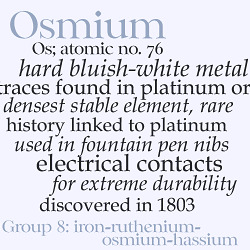
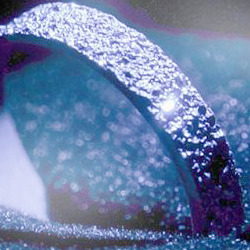
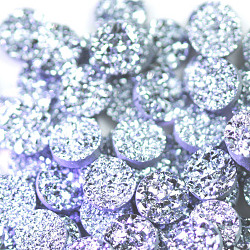


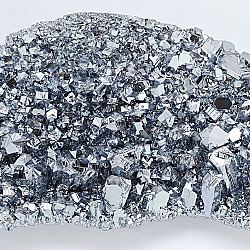
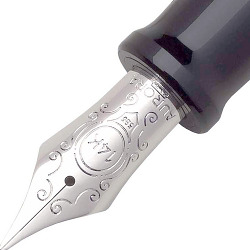

Original & Other Elements 24/?: Osmium
[On gold, silver, mercury, platinum, palladium, rhodium, iridium, osmium:] As in their physical properties so in their chemical properties. Their affinities being weaker, (the noble metals) do not present that variety of combinations, belonging to the more common metals, which renders them so extensively useful in the arts; nor are they, in consequence, so necessary and important in the operations of nature. They do not assist in her hands in breaking down rocks and strata into soil, nor do they help man to make that soil productive or to collect for him its products. (Michael Faraday).
Osmium isn’t mentioned in the series. It’s a rare, hard bluish-white transition metal, found as trace alloys in platinum group metals. It was discovered in 1803 and has the greatest natural density of any stable element. It’s part of Group 8 (along with Iron, Ruthenium, and Hassium) but its history is closely linked to platinum.
It’s used for fountain pen nibs and electrical contacts and for other uses requiring extreme durability and hardness, as well as being used for alloys with platinum and iridium. In compounds, it can be used for staining tissue in microscopy and fingerprinting and for the oxidisation of alkenes. In the early 20th C it was used as a catalyst in producing ammonia (though cheaper alternatives are now used). In its pure state, it’s both volatile and toxic. It’s rare, difficult to work with and expensive.
@pers-books suggested this fascinating element (and fancasting) - sorry it’s taken me so long to get to! (I very much appreciated it. <3)
As far as I can see, Osmium hasn’t yet been used for fic purposes, but clearly there is some definite potential here...
#original & other elements#sapphire and steel#sapphire & steel#original elements#osmium#Jaime Murray#show meta#inspiration#as ever these are only my thoughts#quotes
14 notes
·
View notes
Photo

Libyan Desert Glass
This gemstone shown in the picture is 28.5 million year old silica desert glass, found in-between sand dunes on the border of Libya and Egypt in the Great Sand Sea. People used the glass in the pleistocene era to make tools and carvings, and since its scientific discovery and investigation began in 1932, researchers have been trying to find an origin, but ultimately the reason has remained a mystery.
Color varies from transparent, milky white, light yellow, to a light green or green-brown color. The pieces vary in size and mass, and are often sand and wind eroded smooth on one side, with slight etchings resembling pseudo-regmaglypts, or characteristic grooves like a meteorite, on the other side. This glass contains high levels of silica, at around 98%, and can include many bubbles, dark brown streaks, and/or cristobalite spherulites, which are high-temperature silica structures.
Trace elements found in dark streaks within the glass include iron, magnesium, and aluminum, while wisps of iridium and iron in a low oxidation state point to an extraterrestrial origin for these impurities.
Scientists thought that the glass was formed by the impact of an extraterrestrial body into a sandstone layer, but no crater was found. This led researchers to hypothesize that a low-altitude airburst by a meteorite could supply the necessary heat to melt the sandstone, forming the gems we see today. This tektite would be similar to Trinitite, a glass made from the desert sands in New Mexico during the atomic bomb trial (see this Earth Story post on Trinitite: http://on.fb.me/1JV0IWh ).
A possible crater named Kebira was discovered in 2007, though very little research has been published regarding this site. A study did investigate in 2011, analyzing oxygen isotopes of sandstone taken from glass-containing areas and the proposed Kebira zone. This study determined that the glass did not originate from the proposed impact crater, but that did not identify an alternative source.
In 2013, scientists reported on a meteorite called “Hypatia,” a very hard, black, shiny, carbonaceous material with many fractures and diamond inclusions. Tests suggested that components in this rock formed at temperatures comparable to those found in liquid nitrogen, possibly suggesting that this stone is some of the only comet material found on Earth. Though there are some questions, the team suggests that a cometary nuclei entered Earth’s atmosphere, lost its water content and volatile hydrocarbons while gaining atmospheric noble gases, and then the bolide exploded. A diamond similar to the ones found in Hypatia has been found embedded in Libyan desert glass, possibly suggesting that a comet exploding in the atmosphere was the original source for this material.
On the other hand, a more recent study examined grains found in brecciated rocks associated with the Libyan Desert Glass strewnfield. In those rocks they found minerals like shocked quartz, which require large pressures - up to 20 GPa - to form in the state they were observed in. These pressures were unilkely to be produced during an airburst, leading those authors to again suggest that the Libyan Desert Glass was produced during an impact, but that the remnant crater has been completely eroded away.
-MH
Image Credit: James St. John, http://bit.ly/1zZYj75 References: Aboud, T., 2009, Libyan desert glass: Has its enigma been solved?: Physics Procedia 2, (2009) p. 1425–1432. Kramers, J.D, Andreoli, M.A.G., Atanasova, M., Belyanin, G.A., Block, D.L., Franklyn, C. Harris, C., Lekgoathi, M., Montross, C.S., Ntsoane, T., Pischedda, V., Segonyane, P., Viljoen, K.S., and Westraadt, J.E., 2013, Unique chemistry of a diamond-bearing pebble from the Libyan Desert Glass strewnfield, SW Egypt: Evidence for a shocked comet fragment: Earth and Planetary Science Letters, v. 382, p. 21-31. Longinelli, A., Sighinolfi, G., Michele, V.D., and Selmo, E., 2011, O and chemical composition of Libyan Desert Glass, country rocks, and sand: New considerations on target material: Meteoritics & Planetary Science , v. 46, p. 218-227. https://gsa.confex.com/gsa/2018AM/webprogram/Paper322276.html
Read More: http://geology.com/meteorites/impactites.shtml https://www.temehu.com/libyan-desert-glass.htm http://bit.ly/1EDTy8P
#Science#gem#gemstone#libyan desert glass#desert glass#rock#impact#asteroid#comet#egypt#bolide#sahara#the earth story
145 notes
·
View notes
Text
Ultramet Brand Story - Freedom, Love, Creation
Jewelry itself is a language.
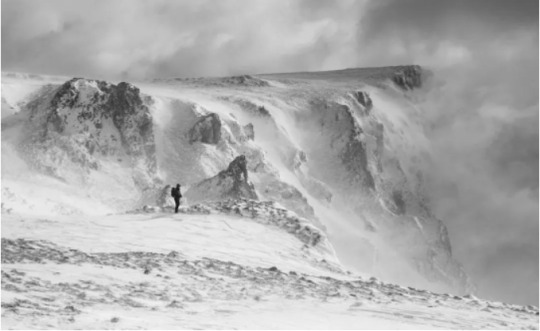
Ultramet originates from the material industry of science and technology where there is a female engineer who adheres to the pursuit of freedom, love, and the joy of creation throughout her life. She has created multiple series of collection-level art works for all people with the same feeling, aiming to select rare material elements on this planet, express the deep world of humanity through the interaction of hearts, the collision of ideas, and the reproduction of art.
Start from here
She believes that everything in nature is properly arranged. She likes being free, spontaneous, and on the go. Only herself is the person who deserves the most attention. She ignored the strange gaze of others, ignored the dull tongues around her, and was obsessed with the things she loved.
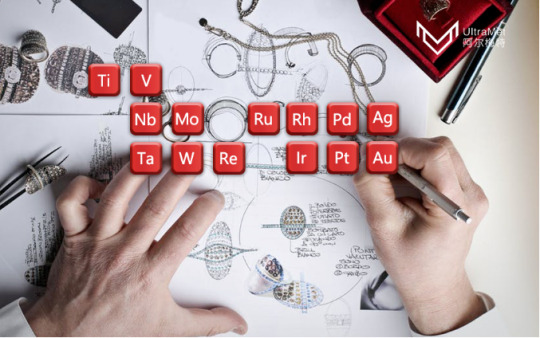
“Scarce Precious Eternal”
Through the daily companion items, we may be able to find another dimension of ourselves, so that we are no longer alone. We may be able to reach the gate of infinity, without ever having to be trapped in the complexities of the real world. We may be able to find the same kind of ourselves and let love and joy go together.
The journey of life becomes meaningful because of understanding, loving, and accompanying each other.
Ultramet Rare Metal Art Series
First work interpretation
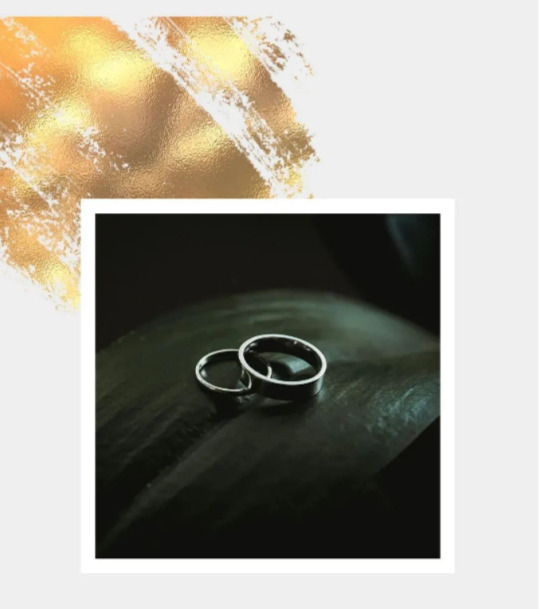
Eternality
- Iridium Series
It represents the persistence and pursuit of love, ideal, career and life, upholding the faithful, unswerving and unchanging style.
Because:
Iridium has the highest density among precious metals (22.56 g/cm3);
Iridium has the second highest melting point (2450°C);
Iridium has the largest resistance to high-temperature ablation (the high-temperature combustion flame nozzle of a rocket missile uses iridium coating);
The reserves of iridium are extremely scarce (the price is second only to rhodium, and the raw material for iridium powder reached an all-time high in 2021, with a market price of 1500 yuan per gram, more than three times that of gold)

Slient Helper
- Molybdenum Series
Whether it's when you're struggling to start, when you're suffering from pain, or when you're at a confused low ebb, there's always a force from the "helper" around you. They either provide you with guidance like a lighthouse, or they take good care of you, or they're quietly busy in front of and behind the scenes, trying to support you and helping you find your own way. For these slient helpers, we need to appreciate, respect and cherish their quality which is also the quality of molybdenum itself.
Because:
Molybdenum has two quality characteristics: omnidirectional fusion and high energy thrust assist.
Molybdenum is a refractory metal among rare metals, and also has high temperature (melting point 2620 ° C), high strength, and corrosion resistance characteristics. Therefore, it is the most important additive element in various high-performance special steels, stainless steel, tool steel, high-speed steel, and alloy steel; The addition of molybdenum in iron and steel smelting is like adding a strengthening agent to a piece of ordinary steel. Its high-temperature strength, toughness, corrosion resistance, wear resistance, weldability, heat resistance, and other indicators have significantly improved compared to before the addition of molybdenum.
In the second and third transition elements of the periodic table of elements, molybdenum is the only trace element that is known to be essential to the human body. Therefore, its biocompatibility is also particularly good. Cobalt chromium molybdenum alloy and molybdenum rhenium alloy are both medical grade options for human orthopedic implant materials approved by the FDA in the United States;
Molybdenum has made the market demand increase year by year due to its high all-round integration with other elements in the steel industry and high energy boost. Under the situation of continuous decline of molybdenum ore reserves and mining output, the price of molybdenum rose three times in 2022, which was almost crazy.

King’s Return
- Rhenium Series
It represents those successful figures who have endured thousands of troops and battles and have always been indomitable. The character of a king is reflected in extreme pressure or test, never yielding, never saying defeat, never giving up, invincible. And they always have excellent qualities of high endurance and tenacity.
Because:
Rhenium has the highest density among rare and dispersed metals (21.03 g/cm3);
It has the second highest melting point (3160°C);
It is the most resistant to high-temperature creep (high-temperature and high-pressure turbine blades of large or military aviation engines are generally made of single crystal superalloys specifically added with the "rhenium effect", and high-temperature combustion flame nozzles of rocket missiles are made of a rhenium based iridium coating method);
Rhenium metal has excellent high-temperature strength, and is the only known metal element on the earth that can maintain tensile strength and yield strength values of over 80MPA at temperatures as high as 2149°C, making it the most resistant rare metal to high temperatures and pressures in history;
The earth's reserves of rhenium are also extremely scarce, accounting for about one tenth of gold reserves, but the current price is less than one tenth of gold. The ultra-high cost performance ratio reserves an imaginative appreciation trend for rhenium metal.

High Mountains and Flowing Waters
- Tantalum&Niobium Series
"High mountains and flowing waters” in ancient Chinese story are a metaphor for the relationship between bosom friends. T&N is an acronym for the element symbol tantalum (Ta) and niobium (Nb). Taken together, the two symbols indicate that when once bosom friends meet in their life, they cannot be separated from each other, as like as niobium in tantalum and tantalum in niobium.
Because:
Tantalum and niobium belong to the same group in the periodic table of elements and are both refractory metals in rare metals. Because they have very similar physical and chemical properties, and their distribution in nature is often co-existing and inseparable, early chemists once mistakenly believed that they were the same element. It was not until 1844 that German chemists successfully separated tantalum and niobium for the first time that the twin brothers of the metal world were able to distinguish each other.
Tantalum and niobium have good physiological corrosion resistance and biocompatibility, so they are often used as body implant materials and surgical tools, such as bone plates, bone screws, implant teeth, roots, scalpels, and so on.
Tantalum and niobium resource reserves are scarce, and their price in rare metals is above the medium level. Due to the similar properties of tantalum and niobium, which are symbiotic and difficult to separate, tantalum and niobium have become the symbol of "close and intimate friends". The T&N series represents the joy of meeting close friends and the invaluable value of friendship.
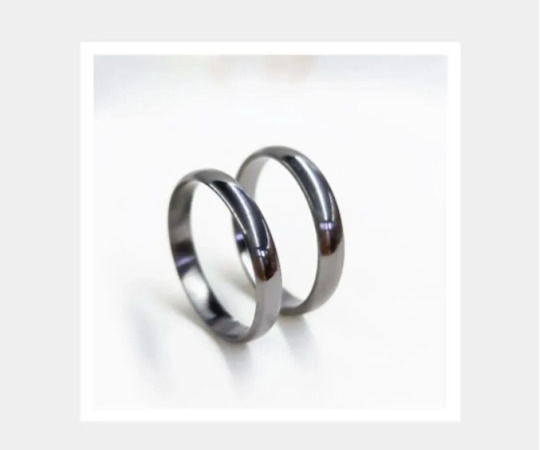
Titanic
-Titanium Series
Titanium has many advantages such as light weight, resistance to chemical corrosion, bacteriostasis, and oxidation resistance. It is almost a universal metal. Titanium art works are named after the homophonic Titanic, which symbolizes the deepest love, protection, and wholehearted dedication in the heart.
Because:
Titanium is a refractory rare metal with many advantages such as corrosion resistance, bacteriostasis, and oxidation resistance, so it is widely used.
Titanium has a "biological affinity" in the human body, which can resist the corrosion of secretions and is non-toxic, and is suitable for any sterilization method. Therefore, titanium is widely used in the manufacture of medical devices, such as artificial hip joints, knee joints, shoulder joints, hypochondriac joints, cranium bones, aortic valve, and bone fixation clips. When wrapped by new muscle fibers, these "titanium bones" begin to maintain the normal activity of the human body. Titanium is widely distributed in the human body, and its content in normal humans is no more than 15mg per 70kg of body weight. Its role is unclear. However, it has been confirmed that titanium can stimulate phagocytes and enhance immunity.
Titanium resource reserves are scarce, and its price is similar to tungsten and molybdenum among rare metals.

Lonely Warrior
- Tungsten Series
It represents those lonely warriors who come from bottom, but are fearless, overcome all obstacles, and forge ahead. "Love how you stand on you own, won’t bow down to anyone, love how you keep fighting on when all hope is gone." The tungsten series is a good illustration of those unique and solitary warriors who come from the wildness and never depend on others in their lifetime. With "the humblest dream, the most aloof dream", they are fearless, they overcome all obstacles, and move forward all the way.
Because:
Tungsten has two main quality characteristics: high melting point and high hardness.
Tungsten has the highest melting point (3360 °C);
Tungsten material has a high hardness, so it is the first choice for hard and wear-resistant materials in industry. Tungsten steel, which mainly consists of tungsten, is also known as cemented carbide and its hardness can reach 94% of diamond;
Tungsten is a key strategic metal element that major military powers around the world attach great importance to. Tungsten reserves are relatively scarce, about 3.7 million tons. Fortunately, China's tungsten reserves are 1.9 million tons, accounting for more than half of the world's total.

Vanadis
-Vanadium Series
The name derives from the discovery of vanadium by the Swedish chemist Sebastian in 1830. Due to the colorful and beautiful compounds of vanadium, it was named after Vanadis, the goddess of beauty in Nordic mythology. Vanadis represents the beautiful and noble goddess, the god with extraordinary bearing, or beautiful expectations and memories in our hearts.
Because:
Vanadium is a silver gray refractory rare metal with a combination of hardness and softness, a lively and variable valence state, and a colorful luster.
Vanadium and molybdenum are similar in that they have many uses in biomedicine, except for being mainly used as additives in steel smelting. Vanadium is crucial in human metabolism and tooth development. Vanadium can promote sugar metabolism and promote the growth of red blood cells. It has a good insulin like effect, can protect islet cells, and reduce blood sugar content in the body. Therefore, vanadium is used as a jewelry material and will not cause allergic reactions or side effects to the human body.
Vanadium resource reserves are scarce, and its price is similar to tantalum and niobium in rare metals, belonging to the upper middle level. Due to the combination of hardness and softness of vanadium, its lively and variable valence, and its colorful luster, vanadium works represent a beautiful and noble goddess, a god with extraordinary bearing, or a beautiful and moving encounter and memory in our hearts.
We will successively launch precious metal works with deep representative significance, such as gold, silver, platinum, palladium, and rhodium series.
Please look forward to them.
Who said that only precious metals can be made into cultural creations and jewelry?
Tungsten, molybdenum, tantalum, niobium, titanium, rhenium...
Each rare metal has its unique charm.
Choose a suitable metal,
to give to your friends and lovers,
to express your true heart.
Ultramet is a newly developed rare metal cultural and creative brand under Ultra Minor Metal Ltd. Ultra Minor Metal Ltd focuses on the manufacturing and sales of refractory metals and alloys, and gradually extends to a group company that integrates the manufacturing, production, and sales of precious metal and even all-metal elements in the later stage. We have mastered the raw materials and processing techniques of most cultural and creative collections. Ultramet also has inherent advantages in the production of cultural and creative products.
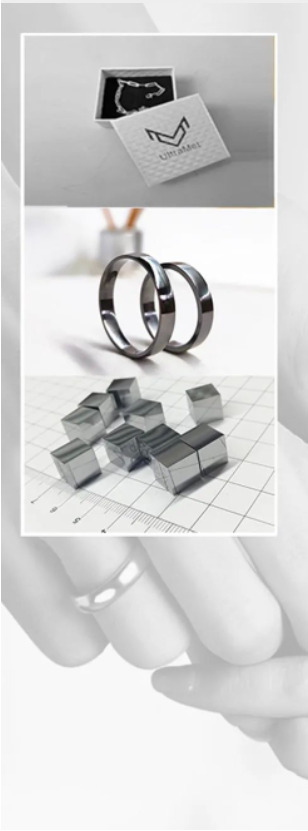
1 note
·
View note
Text
Henri Moissan

During the 1880s, Moissan focused on fluorine chemistry and especially the production of fluorine itself. The existence of the element had been well known for many years, but all attempts to isolate it had failed, and some experimenters had died in the attempt. He had no laboratory of his own, but borrowed lab space from others, including Charles Friedel. There he had access to a strong battery consisting of 90 Bunsen cells which made it possible to observe a gas produced by the electrolysis of molten arsenic trichloride; the gas was reabsorbed by the arsenic trichloride.
Moissan eventually succeeded in isolating fluorine in 1886 by the electrolysis of a solution of potassium hydrogen difluoride (KHF2) in liquid hydrogen fluoride (HF). The mixture was necessary because hydrogen fluoride is a nonconductor. The device was built with platinum-iridium electrodes in a platinum holder and the apparatus was cooled to −50 °C. The result was the complete separation of the hydrogen produced at the negative electrode from the fluorine produced at the positive one, first achieved on 26 June 1886. This remains the current standard method for commercial fluorine production. The French Academy of Science sent three representatives, Marcellin Berthelot, Henri Debray, and Edmond Frémy, to verify the results, but Moissan was unable to reproduce them, owing to the absence from the hydrogen fluoride of traces of potassium fluoride present in the previous experiments. After resolving the problem and demonstrating the production of fluorine several times, he was awarded a prize of 10,000 francs. For the first successful isolation, he was awarded the 1906 Nobel Prize in Chemistry. Following his grand achievement, his research focused on characterizing fluorine's chemistry. He discovered numerous fluorine compounds, such as (together with Paul Lebeau) sulfur hexafluoride in 1901.
0 notes
Text
Rocks never lie, but they do hide...
Who’s ready to talk about rocks? This week’s blog is about geologic stratigraphy. It is the niche study of the layers of rock formations around the world and the points that separate them. I think its cool because it is essentially what we use to turn back geologic history. The contents of rocks tell you everything you need to know about what was around when they formed. I am simplifying as much as I can but would be happy to answer any questions.
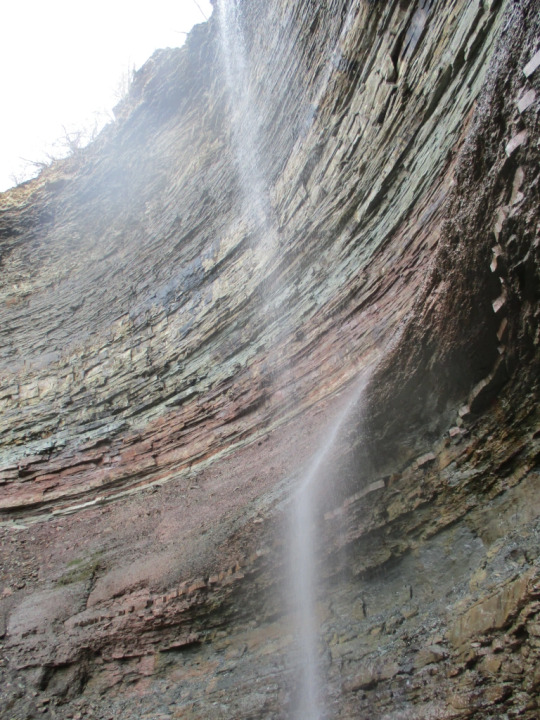
Welcome to the Devil’s Punchbowl! A very pretty waterfall in Hamilton that is a must-see for any rock lovers in the audience. When trying to explain what stratigraphy is and why I think its cool, this is probably the best place to start. Each layer you see here is composed of a unique set of minerals reflecting the environment the stone formed in. This can be seen in the changes in colour and texture – each layer of this striped face represents tens of millions of years of history. Enough time for seas to come and go, repeatedly.
The rocks on top are hard, formed by deposition from shells of a former coral reef. Shells are hard, so the stones they make are hard too! You can see lots of fossils and other cool stuff in these layers. Underneath, the older rocks are much weaker, formed by sedimentation in the shallow sea from while it formed – mudstones, mostly. The weak rocks whether away quickly – the hard rocks don’t whether, but will break off once the layer underneath them gives in. The result? A big fat cliff-face, which we call the Niagara escarpment.
---
Let’s start to get advanced. The place where two rock formations meet is called a ‘contact’. You can find a lot about the history of an area by looking at a contact point between two rock layers. For instance, we had strong evidence that the dinosaurs were blasted away by a meteor before we ever found an impact crater. When looking at the compact between the two geologic periods of time (pre-dinosaurs and post-dinosaurs), geologists found significant traces of iridium, an element that is extremely rare on Earth but common in meteors. Rocks never lie.
Sometimes, extreme events such as large-scale glaciation can weather away formations of weak rocks completely, exposing the bedrock underneath. Eventually, when sedimentation resumes and rocks begin to form again, we are left with a layer of ancient rock overlain by a layer of much younger rock. In these instances, the contact separates rock formations that may demonstrate a large difference in age. We call this an ‘unconformity’, and this is often viewed as a ‘gap’ in the geologic record. All the information stored by the rocks that weathered away is gone forever. Rocks never lie, but sometimes they do hide.
---
And that takes me to my inspiration for this week’s post. Back in the first week, I talked about my trip to the Grand Canyon in Arizona – about how the layers of rock created a story about the history of the region over great stretches of time. Well, I mostly had one specific place in mind, and I’m glad I have the chance to describe it in more detail. The Grand Canyon is home to part of a rock structure called ‘Powell’s Great Unconformity’.
I present you this image. Does anything look out of place?

It looks like the underlying rock was deposited at an angle, but it was indeed flat when it formed there. The rock is so old that the outermost shell of the Earth itself has contorted due to the movement of the mantle, resulting in the angular layer seen within the rim of the Grand Canyon.
The definitive boundary between the flat layer and angular underlying rock makes for a striking visual, but the nature of this division provides a startling insight into our knowledge of the Earth’s past. The sandstone is 550 million years old, which would be staggering if not for the knowledge that the schist directly beneath it is about 1.7 billion years old. I’ll give you a second to think about that.
---
That is a 1.2-billion-year gap in the geologic record. More than a quarter of the history of the Earth. Gone. I hope that after reading my monologue on rock layers, that bothers you as much as it bothers me. This fact may not be amazing or overly interesting to everyone, but I hope that the scale of such a large gap in our ability to interpret history leaves you momentarily stunned and curious as to what could have been.
0 notes
Photo







Archaeological evidence of mass extinctions Planetary biographies below the cut
Aphras is a “heavenly twin,” a planet in a star system that has not one but two worlds of sufficient mass to retain a nitrogen-oxygen atmosphere within the habitable life zone of its parent star. Fossil evidence shows abundant vertebrates and evidence of a sapient terrestrial avian species in its Bronze Age.
However, the only trace of contemporary life on the planet is that of single-celled organisms in its seas. All else has suffered from an extinction event – a series of massive impacts that vaporized vast quantities of water and lofted dust into its atmosphere. Early theories that this event was a collision with a fragmenting asteroid have now been discounted – the impact craters were aimed directly at habitation centers. (see: Tosal Nym)
Atahil is only of note for a few scattered craters. Though flattened by millions of years of high pressure, the marks of orbital bombardment strikes are unmistakable. It is generally accepted among academics that whoever hailed from or settled Schwarzschild’s second planet, Etamis, must have had outposts on Atahil as well.
Bothros is home to a scientific curiosity. Evidence of a primate-like spacefaring civilization was found frozen in its equatorial ice, ranging from melted fragments of metal to preserved remains of the creatures still wearing suits for extra-vehicular activity. Further exploration revealed that their habitation centers were vaporized by orbital bombardments from railgun-like weapons hitting with a force of approximately 120 kilotons of TNT. Only those that fled or happened to be away from the habitats were preserved in the ice, where they died of asphyxiation.
This unknown species did not come from Asteria, but scientific teams are looking for evidence that they visited there. It is difficult to believe they would colonize a frozen rock like Bothros and ignore a lush garden world. Their world of origin is also a mystery.
Epho is a rocky world with an atmosphere of oxygen and carbon dioxide. There are large craters scattered across its surface, obviously from hypervelocity kinetic impactors. Stretching between these locations are the shattered remains of magnetic levitation rail lines, which strongly suggests the craters represent the former locations of arthenni mining outposts or other settlements. The equatorial region contains an extensive network of canyons, formed by the planet’s abundant liquid water. (see: Gaelon, Helyme)
Etamis is a superterrestrial world a third larger than Earth. It is in a “post-garden” state that clearly shows evidence of attack from space. While now waterless, the shores of former oceans show patterns of cratering too regular to be anything but saturation bombardment by dreadnought-class kinetic weapons. Although it is unclear how, most of the atmosphere has been lost.
Archeologists have found little of note. It appears that all settled regions were touched by the global bombardment. The few relics found suggest an advanced spacefaring culture thrived on the world somewhere between from 20 and 40 million years ago. The level of antiquity makes it impossible to estimate the world’s former population, or guess whether it was the race’s homeworld or a colony.
Helyme is a “post-garden” world that once enjoyed an Earth-like oxygen-nitrogen atmosphere. It is still blessed with plentiful water, but a generally cold climate (and extreme seasonal shifts, courtesy of a 38-degree axial tilt).
Helyme is thought to be the homeworld of the arthenn, a spacefaring species which disappeared approximately 300,000 years ago. Precisely what happened to Helyme is still under debate. It appears a global extinction occurred, wiping out all native animal life forms more complex than zooplankton. Plant forms were not affected, but the lack of oxygen-breathing life caused oxygenation of the atmosphere. Plant life was reduced after lightning storms ignited global wildfires.
The leading theory for Helyme’s devastation is an out-of-control biological weapon. For this reason, landing is strictly prohibited. The corporations of Illium have emplaced a network of quarantine satellites to dissuade would-be looters from landing in the crumbling cities. (see: Epho, Gaelon)
Joab is a two-mooned habitable planet that is most well known for its mass extinction event. Thousands of years ago, Joab was home to a primate-like spacefaring civilization as well as abundant flora and fauna. However, this can only be deduced from time capsules put into the ground well outside habitation centers – all cities and detectable dwellings were targeted in a massive orbital bombardment that turned them into vapor. The resulting dust shroud killed all photosynthetic life and all fauna dependent on it. (see: Laban, Mizraim)
Klendagon’s most striking feature is, of course, the Great Rift valley that stretches across the southern hemisphere. What is most fascinating about the Rift is that it does not appear to be natural. The geological record suggests it is the result of a “glancing blow” by a mass accelerator round of unimaginable destructive power. This occurred some thirty-seven million years ago.
Gaelon is surrounded by an extensive ring system. The inner rings are composed pulverized nano-manufactured carbon materials, thought to be the remains of an arthenni helium-3 mining infrastructure. The few pieces of larger debris found indicate a materials technology at least equal to the current galactic state-of-the-art.
The outer rings consist of water-ice, silicate dust, and the odd bit of rock. Analysis of the debris often show [sic] shock damage and evidence of rapid heating. Some para-historical theorists insist that the outer rings represent debris from a moon or moons destroyed by mass accelerator bombardment. This has been rejected by every reputable xenoarcheologist; while it is theoretically possible to destroy a small moon utterly with dreadnought bombardment, no species sees a compelling reason to do so. (see: Epho, Helyme)
Mizraim, a small gas giant, is primarily hydrogen and methane around a rocky core. There is no remaining trace of the civilization from Joab on Mizraim itself, but debris orbiting the planet indicates that artificial satellites were once in place before being destroyed. (see: Joab, Laban)
Klendagon is an arid terrestrial, slightly larger than Earth, but with a lower density that reflects its relative lack of heavier elements. The crust is composed of tin and aluminum, with wide deserts of dust-fine sand that are easily stirred by the wind.
Klendagon’s most striking feature is, of course, the Great Rift valley that stretches across the southern hemisphere. What is most fascinating about the Rift is that it does not appear to be natural. The geological record suggests it is the result of a “glancing blow” by a mass accelerator round of unimaginable destructive power. This occurred some thirty-seven million years ago.
Laban is a desert world with sea upon sea of scorching hot iron oxide wearing away marbleized cliffs. Its atmosphere is thick and layered with significant levels of oxygen trapped under an upper helium layer. Initially, surveyors detected traces of iridium from orbit, only to find a surprising archaeological discovery - the iridium came from bunkers on the surface that were blown apart by a dreadnought-class weapon. The logical conclusion was that the civilization on Joab had reached Laban and its outposts here were destroyed to make their extermination complete. (see: Joab, Mizraim)
Tosal Nym, [ the sister tragedy to the extinction event on Aphras ], was the rarest of jewels; a second garden planet within the same life zone as Aphras. Not as old as its sister planet, its fossil evidence indicates it was home to abundant invertebrate sea life.
However, similar craters to those on Aphras created a dust shroud that killed 99% of biota on the planet. The even spacing of the craters indicates a coordinated, simultaneous attack from points around the globe, rather than an asteroid collision or supervolcanic scenario. (see: Aphras)
Vecchio is a moderately-sized terrestrial world with a thin, hot atmosphere of carbon dioxide and nitrogen. Initial surveys found trace amounts of iridium, but little else of interest in the silicate desert sands that cover much of the surface of the planet.
On a recent tour, the Alliance surveyor ship Kupe discovered a group of partial graves hidden in the equatorial mountain ranges. The ancient skeletons in the burial sites were obviously humanoid but incomplete and poorly preserved, which has made them difficult to identify. Fragments of primitive ceramic grave goods were also found nearby. This raises further questions about who once traveled to this inhospitable planet since the closest garden world, Volturno, has no intelligent life. Human universities are planning further archaeological investigations.

788 notes
·
View notes
Text
NASA-funded Simulations Show How Massive Collisions Delivered Metal to Early Earth
NASA logo. Dec. 5, 2017 Planetary collisions are at the core of our solar system’s formation. Scientists have long believed that after the Moon’s formation, the early Earth experienced a long period of bombardment that diminished about 3.8 billion years ago.
Image above: Artist concept shows the collision of a large moon-sized planetary body penetrating all the way down to the Earth's core, with some particles ricocheting back into space. Image Credits: Southwest Research Institute/Simone Marchi. During this period, called “late accretion,” collisions with moon-sized planetary bodies, known as planetesimals, embedded extensive amounts of metal and rock-forming minerals into the Earth's mantle and crust. It is estimated that approximately 0.5 percent of Earth’s present mass was delivered during this stage of planetary evolution. With the support from a NASA Exobiology grant and NASA’s Solar System Exploration Research Virtual Institute, or SSERVI, researchers at the Southwest Research Institute, or SwRI, and University of Maryland have created high-resolution impact simulations that show significant portions of a large planetesimal’s core could penetrate all the way down to merge with Earth’s core—or ricochet back into space and escape the planet entirely.
Animation above: The simulations show significant portions of a large moon-sized planetary body penetrating all the way down to the Earth's core, and ricocheting back into space. On the right, particles are color coded with temperature, indicated in Kelvin. Animation Credits: Southwest Research Institute/Simone Marchi. For a recently published paper in Nature Geoscience about the topic, Simone Marchi and his colleagues found evidence of more massive accretion onto the Earth than previously thought after the Moon’s formation. The mantle abundances of certain trace elements such as platinum, iridium and gold, which tend to bond chemically with metallic iron, are much higher than what would be expected to result from core formation. This discrepancy can most easily be explained by late accretion after core formation was complete. The team determined the total amount of material delivered to Earth may have been 2-5 times greater than previously thought, and the impacts altered Earth in a profound way while depositing familiar elements like gold. “These results have far-reaching implications for Moon-forming theories and beyond,” said Marchi. “Interestingly, our findings elucidate the role of large collisions in delivering precious metals like gold and platinum found here on Earth.” Researchers at SwRI and the University of Maryland are part of 13 teams within SSERVI, based and managed at NASA’s Ames Research Center in California’s Silicon Valley. SSERVI is funded by the Science Mission Directorate and Human Exploration and Operations Mission Directorate at NASA Headquarters in Washington. Related links: Solar System Exploration Research Virtual Institute, or SSERVI: http://sservi.nasa.gov/ Science Mission Directorate: https://science.nasa.gov/solar-system Human Exploration and Operations Mission Directorate: https://www.nasa.gov/directorates/heo/index.html Planets: https://www.nasa.gov/subject/6960/planets Ames Research Center: https://www.nasa.gov/centers/ames/home/index.html Animation (mentioned), Image (mentioned), Text, Credits: NASA/Kimberly Williams/Ames Research Center/Kimberly Minafra. Greetings, Orbiter.ch Full article
19 notes
·
View notes
Text
Scientists Hunt for the Source of the Universe’s ‘Missing Gold’
We are made of “star stuff,” in the words of astronomer Carl Sagan, which is a poetic reminder that life on Earth is interlinked with cosmic processes that date back billions of years.
But exactly which stars make what stuff is still a matter of some debate. While we know that heavy elements such as gold, silver, and iron are forged by the deaths of stars, or in cataclysmic stellar collisions, it’s not clear what proportion of elements originate from each source.
That’s why scientists led by Chiaki Kobayashi, an astrophysicist at the University of Hertfordshire, developed an updated Periodic Table that includes the stellar origins of elements ranging from carbon through uranium.

The Periodic Table, showing naturally occurring elements up to uranium. Shading indicates stellar origin. Image: Content: Chiaki Kobayashi et al Artwork: Sahm Keily
The results reveal a mysterious gap in our knowledge about the genesis of gold in the cosmos, among many other insights published on Tuesday in The Astrophysical Journal.
The researchers also emphasized that a clear understanding of elemental lineages not only helps us quantify the star stuff in our bodies, but also the intricate evolution of the universe as a whole.
“Stars in the present-day galaxy are fossils that retain the information on the properties of stars from the past,” Kobayashi and her colleagues wrote in the study. “This approach is called Galactic archaeology and can be applied not only to our Milky Way Galaxy but also to other galaxies.”
Scientists are able to estimate the abundance and origin of elements through a variety of techniques. Details about the chemical composition of a star can be directly observed in its light spectrum, and stellar evolution models predict which elements should be created by stars depending on their mass, age, and location.
The Big Bang, the event that kicked off the universe, is the main source of the lightest elements: hydrogen, helium, and lithium. Stars, meanwhile, forge complex heavy elements, including those that are essential for life, such as carbon, oxygen, and nitrogen, or flashy metals like gold, silver, and iron.
The origins of nearly all elements can be traced to several sources, but the new study constrains the contribution of each type of stellar death, explosion, or crash. Modeling such a complex problem requires estimates of the abundance of various star types across time and space, as well as the frequency of the powerful cosmic processes that produce them.
“The relative contribution of each source depends on time and environment (i.e., mass and type of galaxies), and hence it is necessary to use galactic chemical evolution (GCE) models to understand this question,” the team said in the paper.
Collisions between neutron stars, the dead husks of some massive stars, are relatively rare compared to other scenarios, so they are not as prolific when it comes to element creation.
That said, scientists have previously suggested that merging neutron stars may be the most important source of gold in the universe.
The new models published by Kobayashi’s team concluded that too few neutron star collisions have occurred across cosmic time to produce the amount of gold that is estimated to exist in the universe. The team suggests that a special type of spinning supernova, with strong magnetic fields, might explain this “mystery of the missing gold,” as it was described in a release.
Another possibility is that the study underestimated the number of neutron star collisions, given that astronomers have only just begun to directly observe these wild encounters within the past few years.
The breakdown of elements that living stars will create, and eventually sow into the universe, are also visualized in the above Periodic Table. Stars that are over eight times as massive as the Sun are destined to explode into pyrotechnic supernovae. This process is the main source of certain elements, such as neon, silver, and iridium.
Smaller stars, like the Sun, don’t undergo a supernova event. As they are dying, these stars shed their outer gassy layers into their surroundings, a dynamic that enriches the next generation of stars with new elements. This process is a major source of nitrogen, lead, and strontium.
The burned-out corpses of stars like the Sun, known as white dwarfs, sometimes explode in a special type of supernova that supplies much of the universe’s manganese, iron, and nickel.
The phrase “star stuff” encapsulates all of these intricacies in a lovely and succinct way. But behind those simple words lies a mountain of fascinating and ever-evolving research into the mind-boggling variety of elemental origin stories out there in the stellar wilds.
Scientists Hunt for the Source of the Universe’s ‘Missing Gold’ syndicated from https://triviaqaweb.wordpress.com/feed/
0 notes
Link
(NASA) During this period, called “late accretion,” collisions with moon-sized planetary bodies, known as planetesimals, embedded extensive amounts of metal and rock-forming minerals into the Earth's mantle and crust. It is estimated that approximately 0.5 percent of Earth’s present mass was delivered during this stage of planetary evolution.
With the support from a NASA Exobiology grant and NASA’s Solar System Exploration Research Virtual Institute, or SSERVI, researchers at the Southwest Research Institute, or SwRI, and University of Maryland have created high-resolution impact simulations that show significant portions of a large planetesimal’s core could penetrate all the way down to merge with Earth’s core—or ricochet back into space and escape the planet entirely.
For a recently published paper in Nature Geoscience about the topic, Simone Marchi and his colleagues found evidence of more massive accretion onto the Earth than previously thought after the Moon’s formation. The mantle abundances of certain trace elements such as platinum, iridium and gold, which tend to bond chemically with metallic iron, are much higher than what would be expected to result from core formation. This discrepancy can most easily be explained by late accretion after core formation was complete. The team determined the total amount of material delivered to Earth may have been 2-5 times greater than previously thought, and the impacts altered Earth in a profound way while depositing familiar elements like gold.
“These results have far-reaching implications for Moon-forming theories and beyond,” said Marchi. “Interestingly, our findings elucidate the role of large collisions in delivering precious metals like gold and platinum found here on Earth.”
Image: Artist concept shows the collision of a large moon-sized planetary body penetrating all the way down to the Earth's core, with some particles ricocheting back into space.
Credits: Southwest Research Institute/Simone Marchi
Source
8 notes
·
View notes
Text

By Kevin Reeve, onPointTactical
Ever see a fish out of water? It’s typically tragic for the fish.
We humans are like fish. There are serious constraints upon our survival, and we will flop around and die if we don’t have the serious items that we need. Outbreaks of infectious disease. Nuclear war. Civil unrest. Financial crisis.
With all the commotion in the world, I am frequently asked HOW to prepare for all the possible situations we read about in the news.
The answer is you don’t have to. Here’s the good news:
Humans have a limited set of needs. They need to be free from imminent danger. They need to maintain core body temperature. They need water. They need healthy food. They need protection from predators. They need access to Facebook. (Bear with me.)
All these needs are covered in a universal set of survival priorities: personal safety, shelter, water, warmth, food, security, and Facebook. Meeting these priorities allows you to face a wide variety of events and disasters without fear.
The shortest answer is doing the thing. - Ernest Hemingway
Personal safety
If the building is on fire, get out. If the ground is shaking, take cover under a sturdy piece of furniture or stand in the corner of an outside wall. If someone is shooting at you, take cover (cover is defined as something that will stop a bullet. A couch or car door are not cover).
After the immediate threat is mitigated, do a personal medical check. Look for breaks, unnatural bends, holes and leaks. One of the effects of adrenaline is to mask pain, so you must do a visual check. A personal trauma kit or IFAK is essential gear.
Shelter
If I was outside in normal street clothes and the temperature was in the 40s, I would probably be hypothermic in a matter of two or three hours. The body’s core temp must be maintained. This requires protection from cold temperatures, wind, precipitation, and conduction. A tent and a sleeping bag, for instance provide protection from all of these. But it is hard to be active in a sleeping bag. So protection from the cold must also include clothes that insulate and keep you dry. Sitting or laying on cold surfaces drains heat quickly, so some insulation from the ground is essential too. I realize this is rather basic to some, but bear with me.
Water
The human body can go three days without water in ideal conditions. But in high heat, when active, it will dehydrate much more rapidly. This requires that you minimize activity in the heat of the day, and that you replenish water and maintain electrolyte balance. The latter requires the addition of essential trace elements such as calcium, magnesium, and potassium. Sports drinks provide some, but the best source I have found for electrolytes are Nuun tablets or EmergenC packets.
Warmth
An ideal shelter would be one that you can heat without electricity or gas. A tent large enough for a wood stove would work. Having a wood stove in your house is good. But even an outdoor campfire would help provide you with an external heat source. You need to know how to build and maintain a fire. I am amazed at how few people know how to chop kindling or build a teepee fire. Fewer still can start a fire using primitive methods.
Food
In a survival situation, you will need 2,000 to 3,000 calories a day just to keep from starving. If you are working hard physically, you will need close to 5,000 calories per day. That is not an easy task if you are gathering nuts and berries. Essential to that scenario will be animal protein, and especially the fat found in animals. You can hunt and trap, or you can store.
Protection
One of the biggest realities in a major event is the emergence over time of two-legged predators. If the event is serious and long-term, then at some point, the rule of law will be lost. Calling 911 will not get you any help. Law Enforcement will have gone home to take care of their families or they will be completely overwhelmed. Your protection will be your responsibility. How will you protect your family from armed predators? That is a question you must ponder for yourself. I have chosen an approach that some will not be comfortable doing. But how will you protect your family without the necessary training, tools, and will? Skill, will, tools.
The 3-month supply
I recommend stockpiling (if it is done before the event, it is stockpiling, after, it is called hoarding) a three month supply of food. This would include rice, beans, pasta, powdered milk, honey, salt, canned goods, especially fruit, tuna, chicken, and any other canned goods that you would regularly eat. It does not take long to build an emergency supply simply by shopping sales and buying extra. Buy foods you already eat, just buy more. That can of beets may have only been $.39 but will you actually ever eat it? Then rotate new stock into the back of the pantry and use the older first. That way it never expires.
Store water in one or two gallon jugs. Build the supply over time. Jugs are more responsible than individual bottles. Store two weeks, minimum of 1 gallon of water per-person per-day. 1 Person = 14 gallons, etc.
Store extra medication, and hygiene items so as to minimize your need to go to a store in search of these items.
OK. Maybe Not Facebook
Communication with loved ones is a very human thing, especially in extremely uncertain times. Depending on existing communications systems to communicate between family members who are spread around the city when the event occurs is iffy at best. Better to have a family emergency plan that says if the event occurs during the day, mom can get the younger child and dad will swing by and grab the older on his way back to the house. If you have agreed upon protocols in advance, then you take the possibly overtaxed comm systems out of the equation.
You may need to communicate with family members in other cities. The main options are a sat-phone or a ham radio. You will not be able to depend upon cellular service. It will have the bandwidth redirected to emergency services or may be knocked out for a time. I have a pair of iridium sat phones for this purpose.
Liquidity
Try to have some cash on hand in case the banking system is down for a few days. This will perhaps make the difference between getting gasoline and not. Best have a short-term supply on hand.
The Biggest Lesson of Katrina
One of my most basic tenants of preparedness is NEVER ever go to the Superdome. The government will not take care of you. They will maintain order, but they will not necessarily feed you and care for you. If Katrina taught us anything, it taught us that. Being ready for unlikely events is your responsibility. The idea of having that much food may seem completely foreign to some. But it provides a sense of independence and resilience.
Kevin B. Reeve is the founder of onPoint Tactical, llc, a pioneer in the field of Urban Survival and Urban Escape & Evasion. onPoint Tactical trains professionals and select civilians in Scout skills, Off-grid medicine, and more. Visit us on FACEBOOK, TWITTER and website.
www.onPointTactical.com
609-668-5384 Copyright Kevin Reeve, onPoint Tactical 2017
1 note
·
View note